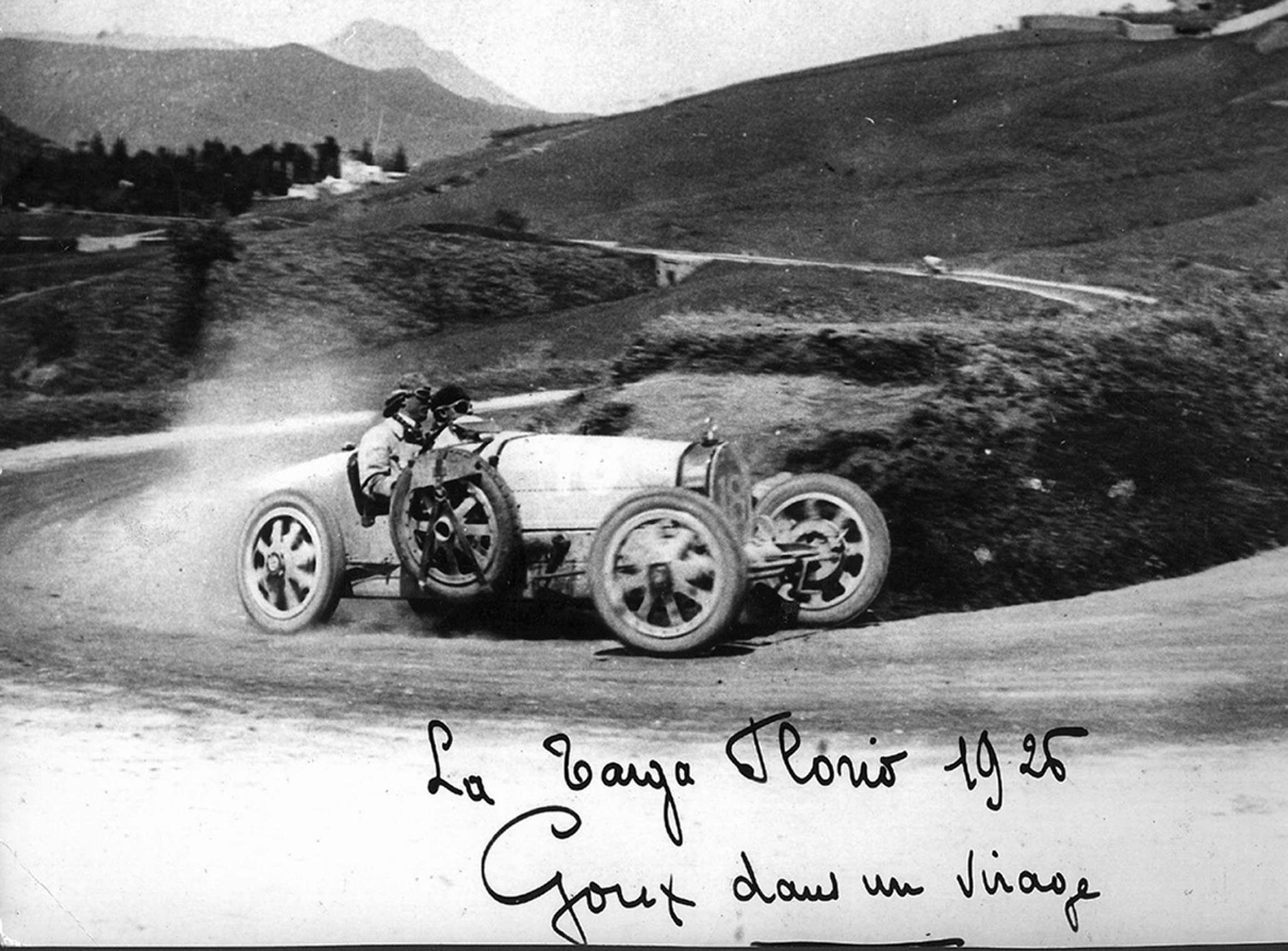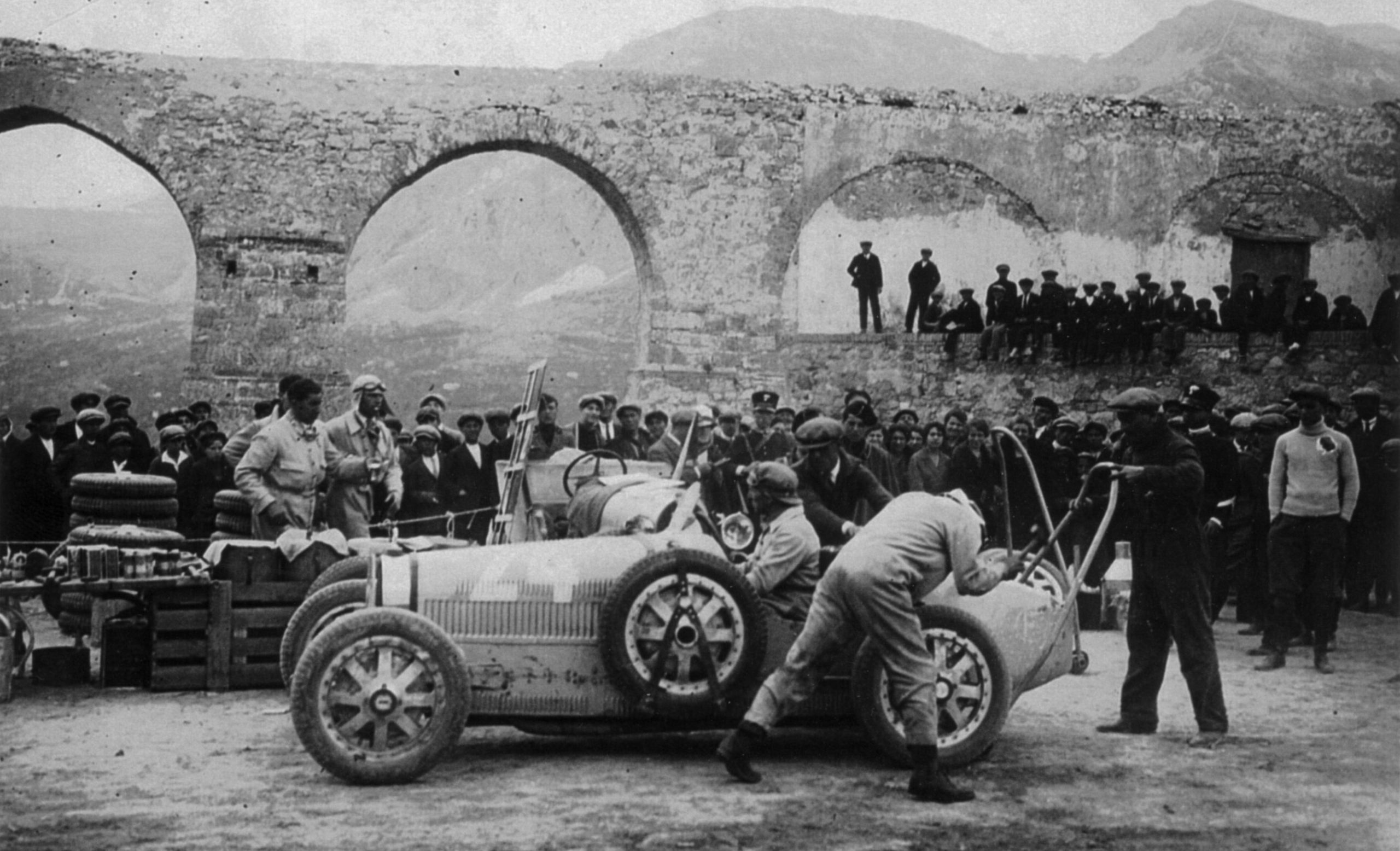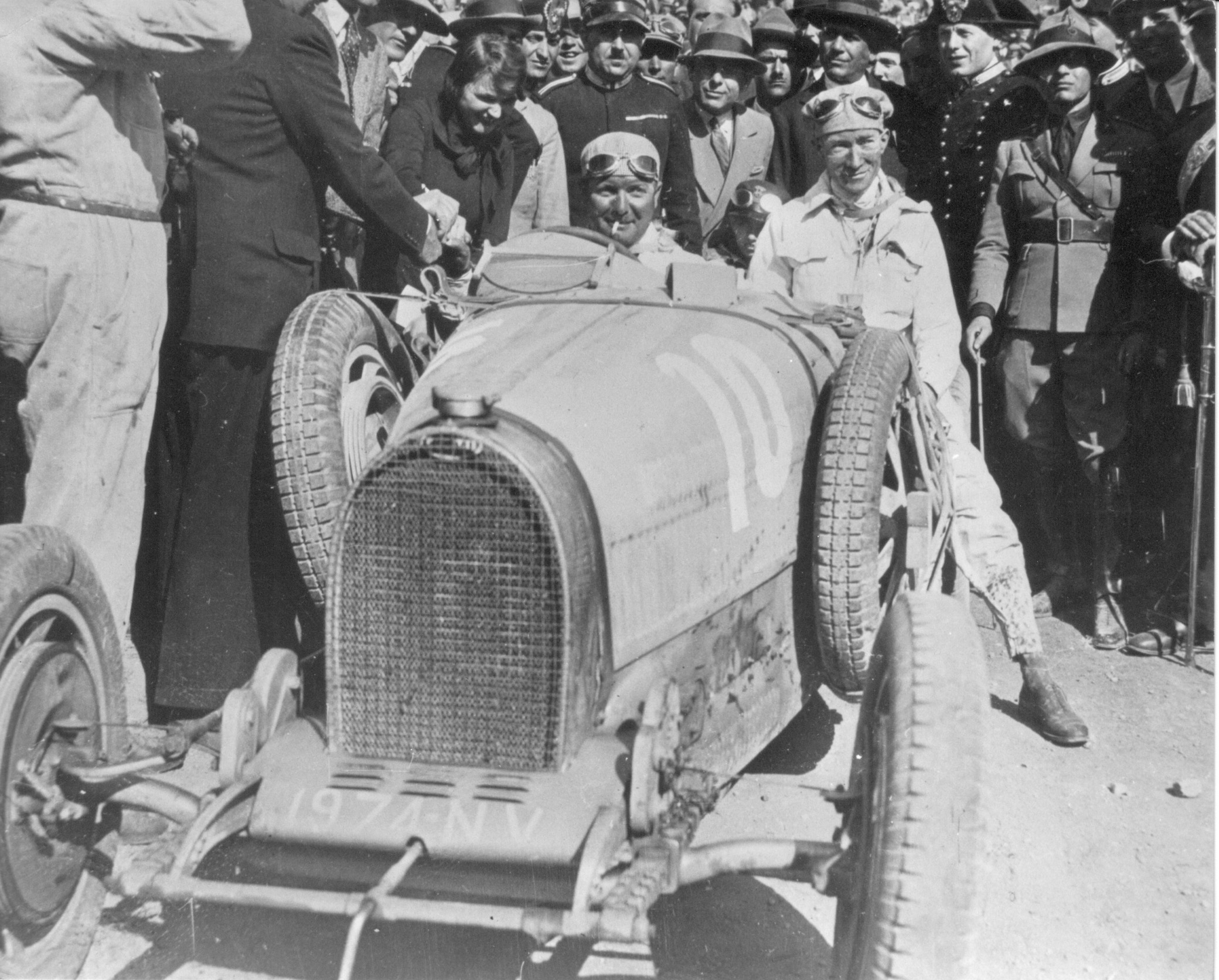
THE TARGA FLORIO VICTORY: BUGATTI WINS FIFTH CONSECUTIVE TITLE
For many years Bugatti dominated the most important car race of the 1920s
Legends were born on this track. Targa Florio in Sicily was considered the world’s hardest, most prestigious and most dangerous long-distance race for many years.
Sicilian entrepreneur Vincenzo Florio established his own race on family-owned roads in the Madonie region. Between 1906 and 1977, sports cars raced for the title at international races, some of which even had sports car world championship status. Winners at this race could proudly advertise their victory. For this reason, all important sports car manufacturers sent their vehicles to Sicily. Between 1925 and 1929 Bugatti dominated the race with the Type 35. In particular, in 1928 and 1929, one man showcased his skills at the wheel of his vehicle: Albert Divo.
In these two years he was unbeatable in his Bugatti Type 35 C, winning the race in Sicily on 5 May 1929 after having also claimed the top spot in 1928. He also set a further record when he crossed the finish line: the “Fabrik Bugatti” team won the title five times in a row – this had never been done before in the history of the Targa Florio and remained an unbeaten record until the end of the last official races, to this day. A reason to look back.
After all, the race was anything but easy: initially one lap of the “Piccolo circuito delle Madonie” was around 148 kilometres, from 1919 organisers cut the race lap distance to a still considerable 108 kilometres. Only a select number of drivers were able to memorise the complete anti-clockwise course with around 1,400 corners and challenges. Five laps covered a distance of 540 kilometres and featured more than 7,000 corners that drivers had to master – on publicly accessible mountain roads. The challenging course led drivers over bumpy as well as dusty roads and in many cases drivers had to dodge small domestic animals that were crossing their path. It was nothing like today’s “sterile” asphalt on Formula 1 tracks. Teams were able to refuel and change tyres at any point on the track, while potentially handing over the vehicle to nominated substitute drivers was only possible in the presence of race directors at the end of each lap.
The Bugatti team prepared for the race in Sicily a few weeks before the event as drivers familiarised themselves with the course. Bugatti set up its base camp in a strategically favourable spot in the mountain village of Polizzi to be able to quickly get to any point along the track in the event of emergencies.
Eight drivers started at the wheel of Bugatti vehicles
Eight of the 29 starters relied on Bugatti models in 1929, including Ferdinando Minoia and Albert Divo. Both drivers dominated the race from the start at Cerda train station, raced across the narrow track to the village of Caltavuturo, continued in their racing cars along the tight and winding roads via Madonie and Polizzi to reach an altitude of over 900 metres in Collesano and Campofelice. From there the course led drivers back to Cerda train station via a coastal road which they drove along at quite some pace. A real challenge for both those at the wheel and their vehicles.
The benefits of the Bugatti Type 35 racing cars were that they were powerful, lightweight, agile and reliable. The 2.0-litre, eight-cylinder engine generated 125 hp thanks to a compressor and reached speeds of over 200 km/h on straight stretches of the track. Consistent lightweight design cut the Bugatti’s kerb weight to under 750 kilograms. Consequently, wheels as well as the engine and transmission housing were already made of aluminium 90 years ago. The forged front axle featured a hollow core which further cut the weight and improved handling. Thanks to larger brake drums, drivers were able to brake even later before corners and thus drive faster for longer.
Only seven cars made it to the finish line
Vehicles started the race individually at three-minute intervals: Ferdinando Minoia paced across the course with a record average speed of 75.98 km/h and crossed the home straight for the first time after one hour and twenty-five minutes while Divo followed around one minute later in fourth position. Divo was already able to overtake two competitors on the second lap even though the gap to Minoia in first place increased by one and a half minutes. However, in as early as the third lap, he cut the gap to 44 seconds before finally becoming race leader in the fourth lap by overtaking his team mate – with a lead of 39 seconds.
The race took its toll and by the end of the fourth lap a mere seven competitors remained in the race, including four Bugattis, two Alfa Romeo and one Maserati. By the fifth and final lap Divo was comfortably racing towards the victory as Minoia, in second place, was unable to catch him up due to a puncture. After 7:15:41.7 hours Albert Divo crossed the line, beating the time he’d set in the previous year by 30 minutes with an average speed of 74.4 km/h. A sensational pace on a Sunday 90 years ago.

Races between 1925 and 1930
1925: one-two for the Bugatti Type 35 in the first attempt
Ettore Bugatti sent his new T35 racing car to Sicily to test it under the most challenging conditions, but also to effectively showcase it to the public. Bartolomeo “Meo” Costantini and the two Viscaya brothers were at the wheel of the Bugattis. Their mission: crowning the Type 35 as the winner in the first attempt. Throughout the first third of the race Peugeot vehicles were in the lead. However, consistency and patience are crucial in long-distance races. After the race leader Christian Dauvergne suffered an accident, his passing team mate Louis Wagner stopped to assist him. In the remaining two thirds of the race, Meo Costantini raced towards the first victory for Bugatti with an average speed of 71.6 km/h, while Pierre de Viscaya secured the one-two finish with yet another perfect lap to claim Coppa Florio.
1926: 1, 2, 3 to defend the title
Ettore Bugatti created a special Type 35 for the following year’s race, the 35T. The T in the model designation was short for Targa. He had not used a compressor in the Type 35T as he considered this to be unfair competition. He only changed his mind at a later point and created the Type 35TC featuring a compressor, a model generally known as the Type 35B. Meo Costantini once again won Targa Florio in the compressorless, eight-cylinder Bugatti Type 35T, this time beating his team mates Fernando Minoia and Jules Goux who were also at the wheel of a Bugatti. A further, perfect lap rounded off Bugatti’s one-two-three finish, with the result that Bugatti and Meo Constantini were once again able to lift the Coppa Florio trophy.

1927: another one-two finish outclassed competitors
Bugatti racing team asked Emilio Materassi to join them in 1927. In his first race with the brand new Bugatti T35C, he won the Tripoli Grand Prix, with an average speed of 132 km/h, and in April the same year he finally won the Targa Florio.
Bugatti celebrated its arguably most comfortable victory at Targa Florio in 1927. The third victory in as many attempts for the Type 35 would have already been a great success in itself. However, Ettore Bugatti felt that much prouder of the victory as competitors stood no chance of claiming the top spot. Materazzi created a whopping gap of 20 minutes to Ernesto Maserati in third place after a total of seven and a half hours, reaching an average speed of around 71 km/h. Conelli, also at the wheel of a Bugatti, came second between Materazzi’s Bugatti and Maserati – yet another one-two finish.
Emilio Materassi and 22 Spectators Fatal Crash at Monza (1928)
In 1928 Materassi founded his own racing team, buying cars and material from the bankrupt Talbot team. Materassi modifying the cars and in June 1928 he won the Grand Prix of Mugello driving a Talbot. On the 17th lap of the 1928 Italian Grand Prix held at Monza, Materassi lost control of his Talbot 700 when he tried to overtake Giulio Foresti’s Bugatti T35C on the main straight at over 200 km/h. The Talbot swerved to the left, jumped over a three-meter deep and four-meter wide protection ditch and a fence, and crashed into the grandstand.
Materassi was killed instantly along with twenty spectators, and a large number of people were injured. The other drivers of the Scuderia Materassi withdrew from the race immediately after the accident, but the event continued and it was won by Louis Chiron.

1928: unlucky Elisabeth Junek, but another win for Bugatti
Elisabeth Junek made a name for herself in Czechoslovakia in the four years prior to this edition of the Targa Florio. She travelled to the race with a trophy cabinet packed with overall victories, wins in several categories as well as fastest lap times – and with the intention of now also claiming international fame. She had already taken part in the race in Sicily in 1927, but had to retire after the first half of the race as a result of a steering fault.
In 1928 she stepped up to the starting grid in her Bugatti Type 35B, challenging elite racers. In thrilling manoeuvres she courageously attacked competitors and challenged other Bugatti drivers as well as Giuseppe Campari in his Alfa Romeo who took over the lead from her after four of five laps. Junek would not be able to reclaim the top spot as a leaking water pump forced her to cut the pace. However, she still managed to finish in fifth place and was celebrated like a winner. Campari might have won the duel with Junek, but he was unable to win the race as Albert Divo raced his Bugatti over the finish line ahead of the Alfa Romeo.

1929: lap record as part of the fifth victory
In 1929, Alfa Romeo drivers were planning on making up for the close defeat in the previous year, but ultimately, the result was no different. Albert Divo once again claimed the victory and this time he even set a new lap record.
1930: unlucky Divo and Chiron
Bugatti and Alfa Romeo once again started at the annual duel in Sicily. In as early as the first lap drivers of both teams broke the lap record set by Albert Divo in the previous year. This time Divo was unable to defend his title and was forced to retire after an accident due to a deformed axle. Nevertheless, it looked like a sixth, consecutive Bugatti victory for large parts of the race until leader Louis Chiron lost control of his vehicle and ended up in the ditch in the last lap. Drivers were unable to win this race for Bugatti, but Albert Divo and Louis Chiron had long since become part of the French manufacturer’s history. Consequently, it is no coincidence that the last two, modern Bugatti models – the currently available Bugatti Chiron1 and Bugatti Divo2 – have been named after these two legendary drivers.
About Albert Divo
Frenchman Albert Eugène Diwo (who only later changed his name to Divo) was born on 24 January 1895 and started training as a ship mechanic at the age of 13. He was a pilot during the First World War and once again worked as a mechanic afterwards. Divo was gifted at the wheel of fast vehicles, making it easy for him to launch a career as a co-driver and driver of racing cars. He started his racing driver career in 1919 for Sunbeam and Talbot-Darracq where he quickly gained success, winning the 1923 Spanish Grand Prix in Sitges.
In 1924 he signed for Delage. He participated in various races from 1922 and claimed his first victory one year later at the Spanish Grand Prix. He was able to add to these victories in the following years. He joined Bugatti in 1928 once his former team retired from racing. In as early as his first year he won the acclaimed Targa Florio at the wheel of a Type 35 B, before repeating his victory a year later in a Type 35 C. He remained at Bugatti until 1933 and worked as a driver and developer. He remained active in motorsports in various functions until his death in 1966. In his honour, Bugatti announced in 2018 that it would be naming its new, now current hyper sports car after Albert Divo, the Bugatti Divo.

You must be logged in to post a comment.